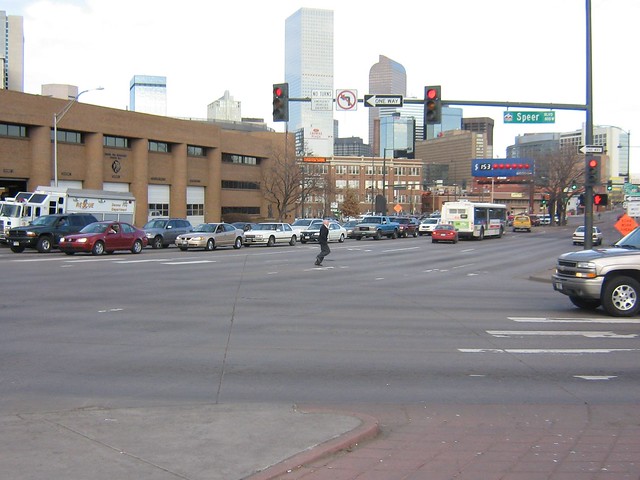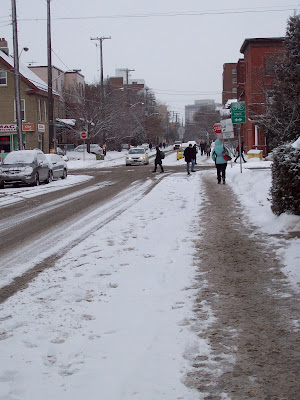This week’s post discusses connectivity - how easy is it for you to get from point A to be B on foot or by bicycle in your community? This follows nicely from last week’s post on compactness and diversity and will sum up the series on sustainability and obesity prevention. Now equipped with this bit of background info, we will be better able to determine which community design options, like the Fused Grid, are better for sustainability, and possibly for our waistlines and overall health.
As I highlighted before, suburban loop and lollipop neighbourhoods are confusing and time-consuming to navigate. They often preclude walking anywhere because of their design; there is never a short, straight line route to where you want to go. In these types of designs there are very few intersections, which are said to increase <driver> safety. However, as the number of intersections increases, the shorter the distance there is to walk from point A to B (motivating people to actively commute), and the more routes you have to choose from, making the walk/ride more interesting (also motivating).
As I highlighted before, suburban loop and lollipop neighbourhoods are confusing and time-consuming to navigate. They often preclude walking anywhere because of their design; there is never a short, straight line route to where you want to go. In these types of designs there are very few intersections, which are said to increase <driver> safety. However, as the number of intersections increases, the shorter the distance there is to walk from point A to B (motivating people to actively commute), and the more routes you have to choose from, making the walk/ride more interesting (also motivating).
 |
| Walking distances for the loop/lollipop design versus traditional grid |
To increase the connectivity of subdivisions, some features discussed in the post on safety could be added, such as way-finding signage for ‘cat-walks,’ as well as adding pedestrian and bike trails through green space, which link different areas within the neighbourhood or the wider community.
Adding biking infrastructure can increase the connectivity over larger areas. I find this especially important for me as I strive to actively commute to work from Aylmer to Ottawa. The National Capital Region is better than many places; we have separate pedestrian/biking pathways and some shared road bike lanes. The City of Ottawa is even planning to pilot a segregated bike lane on Laurier street. Overall, though I find though that the infrastructure is discontinuous and more geared to the leisure walker/biker, not the commuter. For example, you take a bike pathway and suddenly find yourself on the road going the wrong way on a one-way street. Or you have to decide between taking a separate, safer bike pathway that follows the meandering river, or take a direct, much faster, but less safe route that uses the roadway.
The relationship between physical activity/obesity and measurements of street connectivity, such as intersection density and block size, has not been clearly demonstrated in the scientific literature (1-3). However when these measures are incorporated into an overall walkability index that generally includes land-use mix and residential density, more walkable neighbourhoods (with higher intersection density, more mixed land-use, and higher residential density) have been found to relate to decreased obesity among adults (2).
Few studies have been conducted on children, although one study in Alberta found that girls living in highly walkable neighbourhoods were less likely to be overweight than girls in less walkable neighbourhoods, with no difference found among boys (4). Another study in the U.S. did not find a significant relationship between obesity and street connectivity, but did find that children living in neighbourhoods built after 1969 (curvilinear, suburban design) were more likely to be obese than children living in neighbourhoods built before 1970 (traditional, grid iron design with small blocks and lots of intersections)(5).
There is some evidence, as has been discussed in previous posts, that changing the design of the built environment (specifically with regard to increasing safety and mixed land-use) can increase physical activity (this is akin to an experiment)(6). Interestingly, there is also some evidence that improving cycling networks in cities and towns modestly increases cycling (7). However, it is difficult to determine if this results in more new riders or more trips taken by existing riders; the former being much better from a public health perspective. Unfortunately, there are very few studies that examine how changes in neighbourhood/street layout can lead to later changes in physical activity or obesity. Perhaps because randomizing people and telling them where to live is a difficult thing to do. Nonetheless, some researchers are getting around this problem with novel study designs - hopefully with results coming soon.
 |
| On-street marking and separating bike lanes in Manhattan, picture from Active Design Guidelines, NYC |
As I discussed in a previous post, the Centers for Disease Control and Prevention in the U.S. conducted a comprehensive review with the goal of developing recommendations for childhood obesity prevention at the community-level (8). Related to increasing street connectivity, the report recommended that communities should:
- Enhance infrastructure supporting bicycling and walking;
- Enhance personal safety in areas where persons are or could be physically active;
- Enhance traffic safety in areas where persons are or could be physically active.
References
- Saelens BE & Handy SL. Built environment correlates of walking: A review. Medicine & Science in Sport Exercise. 2008; 40(7S): S550-66 http://www.ncbi.nlm.nih.gov/pmc/articles/PMC2921187/
- Feng J et al. The built environment and obesity: A systematic review of the epidemiologic evidence. Health&Place. 2010; 16: 175-90
- Carter MA & Dubois L. Neighbourhoods and child adiposity: A critical appraisal of the literature. Health&Place. 2010; 16: 616-28
- Spence, J. C. et al. Influence of neighbourhood design and access to facilities on overweight among preschool children. International Journal of Pediatric Obesity. 2008; 3: 109-116.
- Grafova, I. B. Overweight children: assessing the contribution of the built environment. Prev Med. 2008; 47: 304-308.
- Heath GW et al. The effectiveness of urban design and land use and transport policies and practices to increase physical activity: A systematic review. Journal of Physical Activity and Health. 2006; 3 Suppl 1; S55-76 http://www.aapca3.org/resources/archival/060306/jpah.pdf
- Yang L et al. Interventions to promote cycling: systematic review. BMJ. 2010; 341:c5293 http://www.bmj.com/content/341/bmj.c5293.full
- Khan LK et al. Recommended Community Strategies and Measurements to Prevent Obesity in the United States. Morbidity and Mortality Weekly Report. 2009; 58(RR-7) http://www.cdc.gov/mmwr/preview/mmwrhtml/rr5807a1.htm


